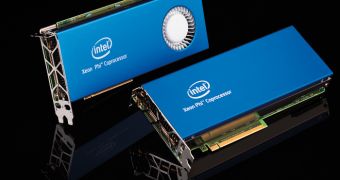Intel's Xeon Phi PCI Express cards were the result of Intel's failed attempt at making an x86-based graphics adapter, but now said adapters are starting to actually phase out themselves, surprisingly enough.
Well, that might come across as misleading, so we'll clarify. Back in 2009-2010, Intel allowed the world to know about the Larrabee architecture, meant to give birth to x86-based add-in video boards.
Early performance figures were very low though, so plans were eventually scrapped. NVIDIA and AMD never had to worry about competition on that front in the end.
Intel didn't let that kill its enthusiasm though, so it took what design elements were viable and made the MIC architecture instead, many integrated cores as it were.
The Xeon Phi PCI Express compute modules were the result of that, a line of add-in boards for supercomputers.
They did not exactly match NVIDIA's Tesla GPU accelerators in raw performance, but they offset that by having native support for all the HPC (high-performance computing) software used worldwide (Tesla, or rather CUDA, needs programmers to design software specifically for it).
So, for a couple of years, NVIDIA and Intel have actually been rivals on the market of HPC PCIe computing.
This may soon stop being the case though, if what the folks at WCCFtech say proves true: that Intel has decided to make some Xeon Phi on LGA instead of PCIe.
LGA is the common socket type for consumer and server CPUs, including Core i3/i5/i7 series, Celeron, Pentium, etc.
In fact, Intel might completely move Xeon Phi from PCIe to LGA, although this does bring the problem of memory.
PCIe cards support GDDR5, and CPUs don't. So, goodbye 512 Bit GDDR5 memory with bandwidth of 352GB/s. However, DDR4 is coming, and while bandwidth will drop to 150 MB/s, memory capacity will rise to 256 GB.
What we can say for sure is that Knights Landing, at least, won't bring with it a total shift to LGA. It will use PCI Express 4 and Skylake MIC architecture.

 14 DAY TRIAL //
14 DAY TRIAL //